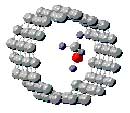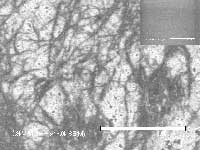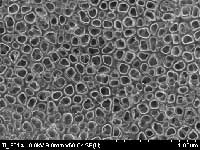Group Nanoscience Projects
Methodology: Combining nanotechnology and surface science for applications in catalysis and sustainable energy production.
Project Examples:
![]()

Carbon nanotubes -- this was a nanoscience teaching project. This paper has been published together will all students of the pChem. lab class.
Methanol adsorption in carbon nanotubes - direct liquid fuel cells
U. Burghaus,1 D. Bye,2 K. Cosert,2 J. Goering,1 A. Guerard,2 E. Kadossov,1 E. Lee,1Y. Madoyama,2 N. Richter,1 E. Schaefer,2 J. Smith,2 D. Ulness,2
and B. Wymore1
1Department of Chemistry, Biochemistry, and Molecular Biology,North DakotaState University, Fargo, USA
2Concordia College, Minnesota, Moorhead, USA
Chemical Physics Letters 442(2007) 344-347
see also Chemical Physics Letters 473 (2009) 131-134
Presented are thermal desorption spectroscopy (TDS) data of methanol, n-pentane, and methanol/n-pentane co-adsorbed on carbon nanotubes (CNTs)supported on silica. Whereas alkane TDS indicates three different adsorptionsites (external, groove, internal), in agreement with earlier studies, onlytwo structuresare present in methanol (MeOH) TDS consistent with the dominanceof strongMeOH-MeOH hydrogen bonding. However, the coadsorption data provideevidencefor MeOH adsorption on interior sites.
![]()

Carbon nanotubes -- molecular beam scattering on CNTs
Adsorption dynamics of alkanes on single wall carbon nanotubes: a molecular beam scattering study
S. Funk, U. Burghaus, Department of Chemistry, and Molecular Biology, North Dakota State University, Fargo
Brian White,1 Stephen O’Brien,2 Nicholas J. Turro, Department of Chemistry, and 2Department of Applied Physics and Applied Mathematics,
Columbia University, New York, New York 10027
Journal of Physical Chemistry C 111 (2007) 8043-8049
The adsorption dynamics of n/iso-butane on “closed”-end (as-prepared, c-CNTs) and open-end (vacuum annealed) carbon nanotubes (o-CNTs) have been studied by molecular beam scattering adsorption probability measurements. Thermal desorption spectroscopy (TDS) and scanning electron microscopy have been used to characterize the CNTs. Evident from TDS data, o-CNTs allow internal adsorption sites to be populated which is correlated with an increase inthe initial adsorption probabilities as compared with c-CNTs, consistentwiththe enhancement in the surface area by opening the tube ends. Furthermore,precursor-mediated (Kisliuk-like) adsorption dynamics were observed. fortheo-CNTs, whereas the c-CNTs show more Langmuirian-like (direct) adsorptiondynamics.
![]()
Model Nano Array Catalysts
A most promising approach is to apply lithographic techniques to manufacture model array nano catalysts. Such systems consist of a predetermined geometrical structure of metal nanoclusters on supports. It has been demonstrated that these structures are indeed catalytically active and show long-term and high temperature stability for some reactions. A collaboration with a nanoscience center at the university in Berkeley and Argonne National Laboratories has been set up to obtain these kind of samples.

TiO2 nanotubes
Inorganic nanotubes
Unexpected Adsorption of Oxygen on TiO2 Nanotube Arrays – Influence of CrystalStructure
S. Funk, B. Hokkanen, U. Burghaus
Department of Chemistry, North Dakota State University, Fargo, USA
A. Ghicov, P. Schmuki
University of Erlangen-Nuremberg, Department of Materials Science, Erlangen, Germany
Nano Letters (Impact factor about 10 > JACS)
Nano Letters 7 (2007)1091-1094
We present kinetics data of O2, n/iso-butane, CO2, and CO adsorbedat ultra-highvacuum conditions on TiO2 nanotube (TiNTs) arrays produced by electrochemical nodization; amorphous and polycrystalline (anatase and mixed anatase/rutile). TiNTs have been studied addressing structure-activity relationships. Oxygen distinctly interacts with the TiNTs whereas this process is not observed on fully oxidised TiO2single crystals. Both molecularly and atomically bonded oxygen have beenobserved. Variations in the binding energies of alkanes were also detected.
